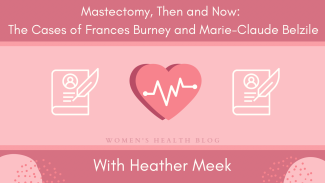Author: Heather Meek, Ph.D., Associate Professor of English Studies, University of Montreal | Editors: Negin Nia & Romina Garcia de leon (Blog Co-coordinators)
Published: July 1st, 2022
Mastectomy and Women’s Health
Frances Burney (1752-1840) and Marie-Claude Belzile (1987-2020), separated in time by two hundred years, can be aligned to the extent that they both underwent mastectomies and felt the impulse to share their stories in writing. Burney’s 20-page letter, written in 1812, and addressed to her sister Esther, and Belzile’s essay Penser le sein féministe, published in 2019, offer accounts of breast surgery written from the perspective of the sufferer. Despite their historical distance from each other, and the significant differences in the virulence of their illnesses and the technical particularities of their treatments, reading Burney’s letter alongside Belzile’s essay reveals, strikingly, how certain aspects of the experience of mastectomy have remained consistent over time.
Belzile’s text draws out the latent political potential of Burney’s account as it moves beyond the personal into larger contemporary feminist and LGBTQAI+ contexts and explores the politics of breast reconstruction. Both works serve as testaments to the importance of patient narratives to the history of women’s health, especially as explorations of the complexities of women’s relationships to their post-surgical bodies and appraisals of institutionalized medical practices and rituals. Burney’s and Belzile’s narratives depict medical encounters that exceed an ethos of biomedical conquest as they capture remarkable encounters with bodily variation and death.
Burney and Belzile’s Point of View
Burney and Belzile both grapple with physical and psychic loss as they contemplate the prospect of surgery and the fate of their breasts. Anticipating what she believed would be a tumour excision, Burney confesses to her feelings of “dread & repugnance, from a thousand reasons besides the pain”. She gestures implicitly to what it meant to lose a breast, which in this period was understood as a material entity integral to the life of the female body, and as a powerful symbol of maternal tenderness, feminine beauty, and sexual pleasure.
Belzile acknowledges explicitly such multivalent cultural meanings of the breast and brings them into the current moment, explaining that hypersexualized breasts are, rather puzzlingly, displayed everywhere even as they are viewed as objects to be “concealed from male onlookers, revealed only in intimacy”*. She at once denounces and transcends such patriarchal notions as she mourns, in a way uniquely her own, the loss of her own breasts, remembering how she was forced to “think about the future of my chest in the urgency of a few weeks” when she received her cancer diagnosis.
While Burney’s account predates the consolidation of a distinct medical profession, and Belzile’s case is situated in our current age of rapid medical innovation, both authors offer critical accounts of entrenched rituals and systems that silence, objectify, or disregard female patients. Burney is unprepared when “seven men in black” enter her operating room, when her face is covered in a semi-transparent veil, and when she learns, for the first time, mere minutes before the surgeons begin the excision, that her entire right breast will be removed.
One might assume that such astonishing details are relics of Burney’s period, but Belzile describes not being listened to by her surgical team, which she fortuitously discovered had planned to insert, during her operation, tissue expanders to make possible an eventual reconstruction which she had made adamantly clear she did not want. She presents this not as a rarity but as a systemic problem – as one among many instances of breast cancer patients’ choices being discounted or trivialized.
The Idealized Female Body
Both Burney and Belzile refuse to elevate an idealized, supposedly ‘whole’ female body, forcing their readers to come face-to-face with the physical realities of mastectomy. Burney, whose 20-minute operation took place before the advent of anesthetic, describes how “the dreadful steel was plunged into the breast – cutting through veins – arteries – flesh – nerves” . Evoking her own bilateral mastectomy, Belzile celebrates the altered realities of women’s bodies, and affirms that “a flat chest is a chest that exists”. Belzile’s essay and Burney’s letter resonate with Audre Lorde’s lyrical embrace, in her Cancer Journals (1980), of a vocal coterie of one-breasted women.
A final link between Burney’s and Belzile’s accounts is found in the way they resist triumphant narratives of the sort Susan Sontag scrutinizes in her foundational essay Illness as Metaphor (1978) – ones in which medical cure is “the great destination,” ‘survivor’ and ‘military’ metaphors of illness flourish, and the realities of mortality are averted. Burney, even as she assures her sister of her “perfect recovery”, maintains that she is traumatized by this “terrible business” whose recollection is “painful”. She thus refuses a comfortable return to her previous self. Belzile’s raw recognition of the departure of her “before body” is described, paradoxically, in poetic and exultant prose as she insists that a woman can reclaim her “body, welcoming with compassion its history, its scars, and its transformations”. This optimism does not, however, preclude a recognition of what Lorde calls our temporary status “upon this earth”. The specter of death looms, since, as her reader knows, Belzile’s cancer is incurable and will eventually consume her.
Transcending historical boundaries and speaking to each other across centuries, Belzile and Burney, together, provide stunning images of flat and one-breasted chests, brave recollections of bodily violation and transformation, and extraordinarily honest confrontations with mortality.
*All quotations in this essay from Belzile’s Penser le sein féministe were translated into English by Heather Meek.
